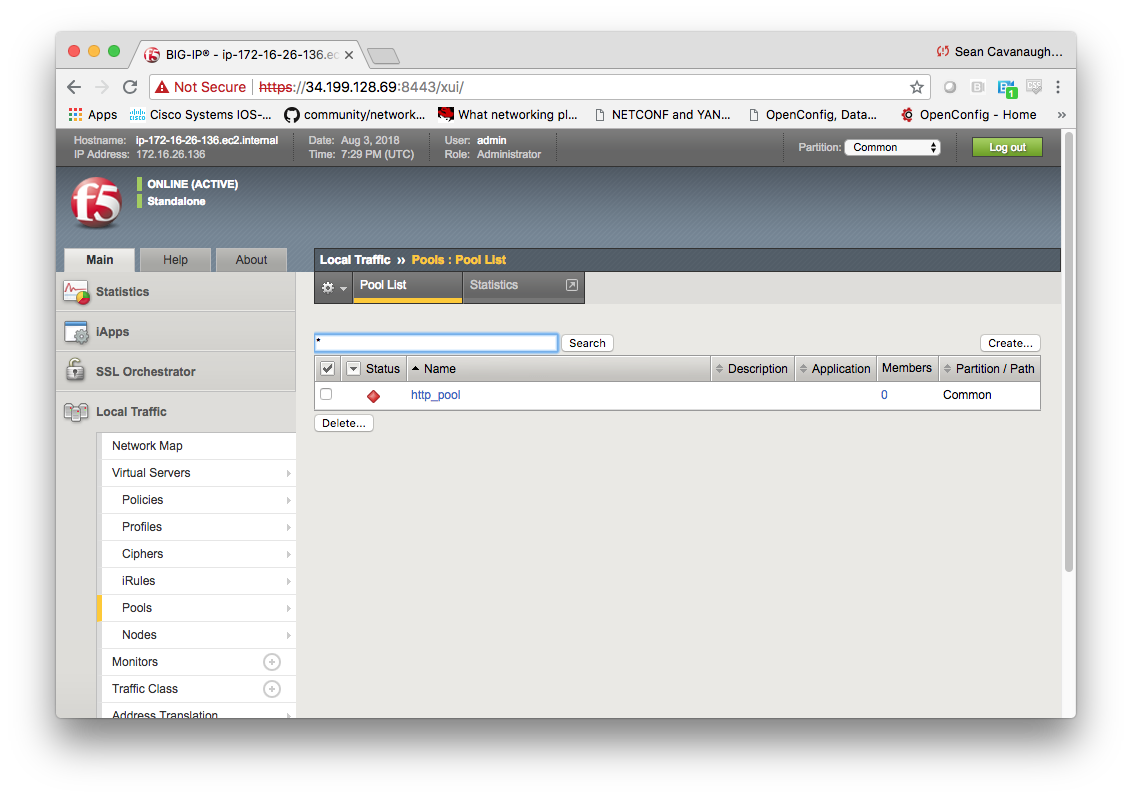ANSIBLE
Training Course for Ansible Automation
This project is maintained by DLT-Solutions-JBoss
Exercise 1.3 - Adding a load balancing pool
Table of Contents
Objective
Demonstrate use of the BIG-IP pool module to configure a load balancing pool in BIG-IP device. A load balancing pool is a logical set of devices, such as web servers, that you group together to receive and process traffic.
Guide
Step 1:
Using your text editor of choice create a new file called bigip-pool.yml.
[student1@ansible ~]$ nano bigip-pool.yml
vimandnanoare available on the control node, as well as Visual Studio and Atom via RDP
Step 2:
Enter the following play definition into bigip-pool.yml:
---
- name: BIG-IP SETUP
hosts: lb
connection: local
gather_facts: false
- The
---at the top of the file indicates that this is a YAML file. - The
hosts: lb, indicates the play is run only on the lb group. Technically there only one F5 device but if there were multiple they would be configured simultaneously. connection: localtells the Playbook to run locally (rather than SSHing to itself)gather_facts: falsedisables facts gathering. We are not using any fact variables for this playbook.
Step 3
Next, add the first task. This task will use the bigip_pool module configure the two RHEL web servers as nodes on the BIG-IP F5 load balancer.
---
- name: BIG-IP SETUP
hosts: lb
connection: local
gather_facts: false
tasks:
- name: CREATE POOL
bigip_pool:
server: "{{private_ip}}"
user: "{{ansible_user}}"
password: "{{ansible_ssh_pass}}"
server_port: "8443"
name: "http_pool"
lb_method: "round-robin"
monitors: "/Common/http"
monitor_type: "and_list"
validate_certs: "no"
name: CREATE POOLis a user defined description that will display in the terminal output.bigip_pool:tells the task which module to use.- The
server: ""parameter tells the module to connect to the F5 BIG-IP IP address, which is stored as a variableprivate_ipin inventory - The
user: ""parameter tells the module the username to login to the F5 BIG-IP device with - The
password: ""parameter tells the module the password to login to the F5 BIG-IP device with - The
server_port: 8443parameter tells the module the port to connect to the F5 BIG-IP device with - The
name: "http_pool"parameter tells the module to create a pool named http_pool - The
lb_method: "round-robin"parameter tells the module the load balancing method will be round-robin. A full list of methods can be found on the documentation page for bigip_pool. - The
monitors: "/Common/http"parameter tells the module the that the http_pool will only look at http traffic. - The
monitor_type: "and_list"ensures that all monitors are checked. - The
validate_certs: "no"parameter tells the module to not validate SSL certificates. This is just used for demonstration purposes since this is a lab.
Step 4
Run the playbook - exit back into the command line of the control host and execute the following:
[student1@ansible ~]$ ansible-playbook bigip-pool.yml
Playbook Output
The output will look as follows.
[student1@ansible ~]$ ansible-playbook bigip-pool.yml
PLAY [BIG-IP SETUP] ************************************************************
TASK [CREATE POOL] *************************************************************
changed: [f5]
PLAY RECAP *********************************************************************
f5 : ok=1 changed=1 unreachable=0 failed=0
Solution
The finished Ansible Playbook is provided here for an Answer key. Click here: bigip-pool.yml.
Verifying the Solution
Login to the F5 with your web browser to see what was configured. Grab the IP information for the F5 load balancer from the lab_inventory/hosts file, and type it in like so: https://X.X.X.X:8443/
The load balancer pool can be found by navigating the menu on the left. Click on Local Traffic-> then click on Pools.

You have finished this exercise. Click here to return to the lab guide